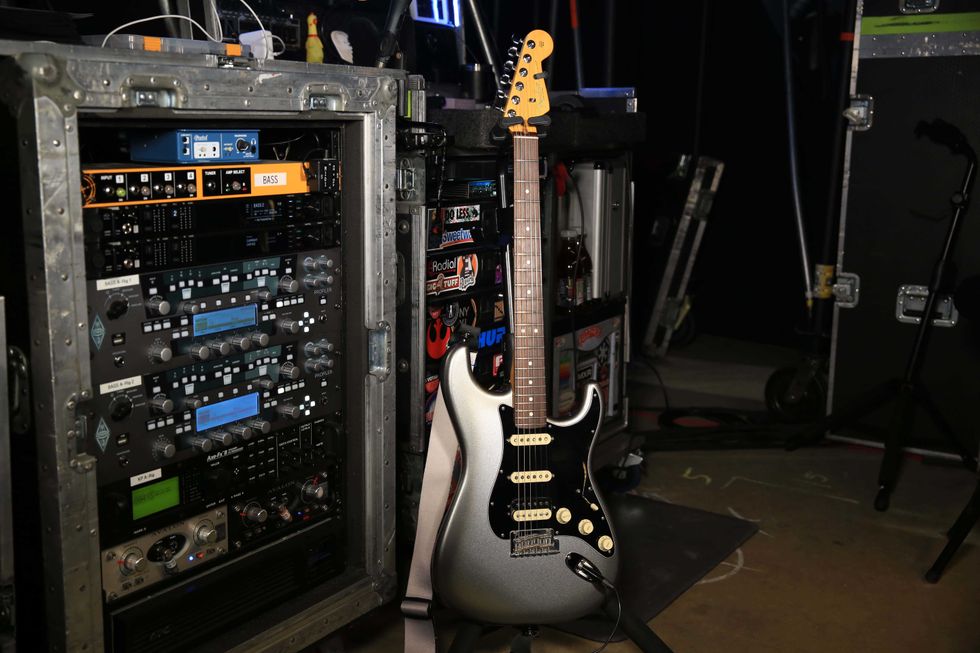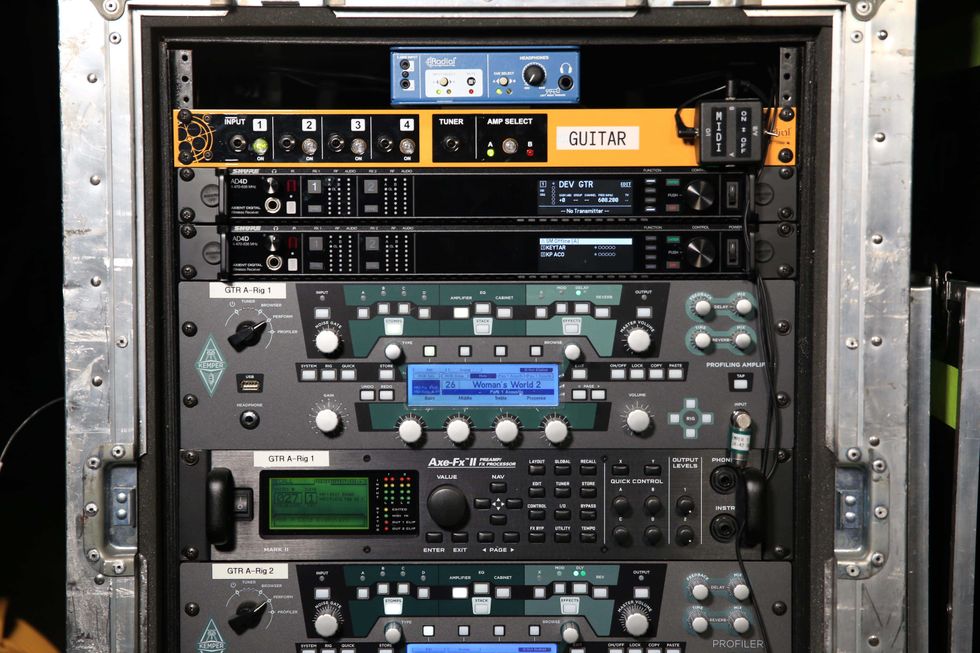Minus the Bear’s Jake Snider and Dave Knudson seem to take great delight in shredding the indie-rock blueprint every chance they get. From the cerebral math-prog of the band’s 2002 debut, Highly Refined Pirates, to the polished art-pop of 2012’s Infinity Overhead, their freewheeling approach to guitar interplay and songcraft has always drawn on a wealth of musical styles. And now—with a new drummer in the fold, and a new producer at the controls—the band’s sixth album, VOIDS, chronicles yet another multi-layered fresh start.
But, as many artists learn after years at their craft, sometimes you initiate change, and sometimes change is thrust upon you. The latter came down hard on the Seattle quintet in early 2015, when—after five albums and more than a decade in the trenches together—Snider, Knudson, keyboardist Alex Rose, and bassist Cory Murchy parted ways with original drummer Erin Tate just as they were mapping out their first stab at new material in almost three years. For a moment, Knudson feared the worst.
“We were in a holding pattern for a while,” he says, “and at least on my part, there was a little bit of concern—like, is the band going to continue? Can we keep doing this? We’d written probably six songs with Erin, and once he left the band, we just scratched those and started fresh. We asked Kiefer [Matthias], our drum tech, to come in and help write the record, and that ended up being amazing. In two weeks we probably wrote nine pieces of music—not complete songs, but for us it’s incredibly prolific. That sparked a lot of enthusiasm in terms of starting fresh and moving forward. We just went at it with all guns blazing.”
At the same time, the band decided to clean house in search of an entirely new sound—a feat in and of itself, since Minus the Bear’s musical twists and turns have always been hard to pin down. Although rock has always been their foundation, over the years they’ve dipped exuberantly into prog, psych, glitchy electronica, and even avant-pop, often with their former keyboardist and longtime friend Matt Bayles (known for the layered clarity he’s brought to such heavy stormbringers as Mastodon, Isis, Russian Circles, and Mono) at the mixing board.
They finally connected with Brit producer Sam Bell, whose work with electronically inclined U.K. bands (including Bloc Party, Snow Patrol, Editors, and the Wombats), deft touch with multiple instruments, and easygoing demeanor won over everyone in Minus the Bear. “I think Sam had the best, most like-minded approach to what we wanted to do,” Snider notes. “Going from the unknown where we were, it was a nice transition. We didn’t know who was going to do the record, and it had been a long time since Infinity Overhead had come out. Sam just fell into the group very easily and became a friend and an advocate for what we were doing. So he wasn’t a stranger for very long.”
VOIDS—aptly named for the sense of loss the band was dealing with, as well as the creative vacuum they sought to fill—might be Minus the Bear’s most adventurous release to date, especially where the guitars are concerned. Loaded with rich textures and groove-thickened riffs, and peppered with Knudson’s signature chord-tapping and looping (using a bank of three Line 6 DL4 delay modelers), the atmosphere gets a noticeable boost from Bell’s ear for programming and tone-shaping.
“We would try a lot of parts,” Snider says, describing the early tracking sessions at Stone Gossard’s Studio Litho in Seattle. “I’d lay something down, and then we’d swap out the guitars, reverb pedals, amps—just trying to find the specific texture that Sam was looking for. I’d never been utilized that way—where there wasn’t any expectation. So it wasn’t like, ‘Is your riff cool enough?’ It was more, ‘Can we add some cool ear candy to what’s already there?’”
From the shimmery fretboard-tapped cascades that open the anthemic single “Invisible” to the mud-thick riffage and whistling leads of “Give & Take,” Snider and Knudson unleash a rich palette of sound that in some ways harks back to the near-symphonic arrangements of early gems like 2002’s “Absinthe Party at the Fly Honey Warehouse,” but with much more spatial dimension and depth. The album opener, “Last Kiss,” channels the dancefloor-heavy mood of French electronic artists like Jackson and His Computerband, while “Tame Beasts” pushes a relentless beat with locked-to-the-rhythm licks and swirling guitar samples. Further on, the album closes with the oceanic trip-pop of “Lighthouse,” its backwards-looped guitars and bit-crushed Omnichord effects channeling vintage Massive Attack or even Trevor Horn-era Seal.
“I wanted to have different tonalities that hadn’t been on a Minus the Bear record before,” Knudson explains. For the meat and potatoes, he relied primarily on his two stalwart Paul Reed Smiths: a Custom 24 and a goldtop McCarty. From there, anything was possible with Bell in the producer’s chair. “Sometimes we’d record just completely dry and then Sam would make it sound really bizarre—that happens in ‘Invisible’ in a few places. And then we talked a lot about having more synth-like guitar sounds, with Sam giving us some great pedal suggestions—the Malekko B:Assmaster was one. I mean, it was very organic. We nerded-out on amps, pedals, effects—all that stuff. Once he understood what we wanted to achieve, we were completely on the same page.”
It seems like a lot of the compositional approach to this album was almost improvisational, especially with Sam Bell onboard.
Jake Snider: Yeah, there’s a mixture to it, and there wasn’t as much of that on our last album. Over the last few records, I did have more of a complete idea of what I was supposed to do. I don’t advocate for not doing your work or anything like that, but sometimes not having things completely done proved to be an interesting way to get to something new that I wasn’t used to doing. So Sam might hand me a Fender Coronado II and be like, “All right, this is certainly not what you sound like, but let’s get this totally different tone on the record and see where it fits.” And some of the songs came together rather late in the process, but that was kind of cool, because then I was used as a tool for Sam to create these textures. I’d tell him, “I don’t have a part,” and he’d say, “Well, do something … stabby.” And I’d think, okay—I can do stabby. So I’d go in there and stab away, and then he’d shout, “Massive reverb, mate!” And I’d kick in the reverb and give him some of this shimmery whammy-bar stuff.
Dave Knudson: We did a lot of that with the amp combinations, too. It was like, are we gonna use my PRS Sonzera with my Fender Twin, or are we gonna use the Verellen Ravine? That’s an incredible amp that we used a lot. It’s based off a ’50s jazz amp that Ben Verellen was commissioned to build by someone else, and now they make it together. It just sounds so beautiful. I mean, the Twin was being used pretty much all the time, and then we’d swap out a second amp to get some different tones, whether it needed to be more high gain or low gain, or bright and crisp, or more subdued with less high range.
And then there were the synth-like guitar sounds that I mentioned. “Lighthouse” is a good example. It’s got that backwards guitar sample that happens throughout, and that came about in a weird way: It started with the Suzuki Omnichord OM-100 that I used on the OMNI record [2010], which is prominently featured on “My Time”—the first song off that album. I had that hooked up with different rhythmic and bass tracks going, and then I sent one of them to my pedalboard. Then I looped the main phrase and added a bunch of effects to it. So at the beginning of “Lighthouse,” that’s the Omnichord that gives it a synthy quality, but it still has the flavor of a guitar.
Knudson’s pedalboard boasts three Line 6 DL4 Delay Modelers. “I use one for standard delays,” he says, “and the two on the bottom are exclusively for sampling, looping, and re-triggering.”
Since Dave talked about his amps, Jake, do you want to talk about which amps you relied on for the VOIDS sessions?
Snider: I’m very stoked on the [Vox] Hand-Wired AC30 I have now. It’s my brain’s idea of what my guitar should sound like. It’s straight off the shelf. The only change I made was to put an alnico Celestion Blue speaker in it. I also have an AC30 Custom Classic that had alnico Blues in it, so I just swapped one for one—so each amp now has one Celestion Greenback and one alnico Blue. I also used a Goodsell Custom 33 as kind of a counterpoint. Both amps are definitely in the same world, but they have different characteristics.
How about guitars? Both of you have go-to guitars on the road—Jake, you usually have an Ibanez Roadcore or Talman, and Dave, you have the two Paul Reed Smiths. Did you change that up to make the album?
Snider: Yeah, on this one I did play a lot of different guitars. I used the new Ibanez Talman quite a bit—the Tele-style Talman. And I had a Music Man Cutlass, and I used a Strat just to get that middle-pickup sound, which is a huge change for me from the Tele. Sam would throw me in there with a Strat and a ton of reverb, and I’d play these high, twinkling chords with a lot of whammy-bar stuff, so there’s some of that on a few tunes. But actually my main guitar the past couple of years on the road has been this Esquire parts guitar that Old Town Music in Portland made for me about 20 years ago. It’s got a real growly, almost P-90-ish sound. We were using a lot more of a single-coil sparkle on this recording.
Knudson: Honestly, I pretty much used my two PRSs the entire time—probably 90 percent. There was a lot of mixing of amps and pedal combinations, but those guitars—they’re like home for me because I’ve had them for years. I feel so comfortable playing them, they sound great, and you can get a lot of different tones out of them, whether you’re coil-tapping or at the bridge or the neck pickup. They’re really versatile, they’re easy for me to play—I mean, I love the PRSs.
Known for playing this T-style Ibanez Talman onstage, Jake Snider recently expanded his 6-string arsenal to include a 20-year-old Esquire-style parts guitar. Photo by Ryan Muir
Dave, how did you first come across those PRS guitars?
Knudson: Well, my old band Botch was done—we were about to play our last show—and Minus the Bear had just started. I was really only playing Les Pauls, but I knew I wanted to get a different guitar because I was writing all these intricate, tappy riffs where the rhythmic and melodic space were a basis for a lot of these songs that Minus the Bear was starting to write. I love my Les Pauls, and they’re great for heavy music, but I wanted something that would be easier to play.
I’d always thought Paul Reed Smiths were pretty cool, so I went guitar shopping at Al’s Guitarville in Seattle. They had this beautiful McCarty goldtop there—that was my first one, and it started my love affair with all their stuff. It was the playability. I love the sound, but the PRS just felt a lot more suited to what Minus the Bear was doing. Plus, on the Les Paul, it’s hard for me where the pickup selector is located—it’s right where my palm normally is [when tapping], so I needed a guitar where, logistically, my hand won’t be impeded by a switch.
Dave Knudson’s Gear
Guitars• PRS Custom 24
• PRS McCarty
Amps
• PRS Sonzera
• Fender Twin Reverb
Effects
• Line 6 DL4 Delay Modeler (3)
• Strymon TimeLine
• Barber TonePress
• DigiTech Whammy
• Boss CS-3 Compression Sustainer
• Boss DD-20 Giga Delay
• Boss PS-2 Digital Pitch Shifter/Delay
• Boss RC-3 Loop Station
• EarthQuaker Devices Bit Commander
• Dunlop Cry Baby wah
• Ibanez Tube Screamer Mini
• Suzuki Omnichord OM-100
Strings and Picks
• Ernie Ball Regular Slinky (.010–.046)
Jake Snider’s Gear
Guitars• Ibanez Talman
• Ibanez Roadcore
• Ernie Ball Music Man Cutlass
• Esquire-style “parts” guitar with Righteous Sound
Amps
• Vox AC30 Hand-Wired with one Celestion G12M Greenback and one Celestion Blue speaker
• Goodsell Custom 33
Effects
• Line 6 DL4 Delay Modeler (2)
• XoticEP Booster
• Ibanez TS808 Tube Screamer Reissue
• Ibanez Tube Screamer Mini
• EarthQuaker Devices Organizer
• Mu-Tron Phasor
• Fuzzrocious Afterlife
Strings and Picks
• Ernie Ball Regular Slinky (.010–.046)
Let’s talk a little more about specific new songs. The punches you guys are playing together on “Give & Take” make that song sound big.
Snider: I think Dave and I do the counterpoint thing pretty successfully on that one. He’s holding down this really heavy, octave-based, very full-sounding riff that just goes up—what is it, D, G and then another chord?—and with a pretty deep groove. Then when the vocals kick in, I’m playing that reedy little guitar with a lean little melody through an EarthQuaker [Devices] Organizer. Then Cory comes in [on bass] with his massive reinforcement. That’s just fun—to get that big sound. Everybody feels the force of it, where you get the space helping to create the weight of things. I think almost every tune like that had most of us in the room together while we were tracking.
Knudson: Kiefer would always play that beat at soundcheck, and I really liked it, so one day on tour I just played along—and all of a sudden the song was born. I have a DigiTech Whammy pedal on the verses and the solo. It adds a nice harmonic texture. I can’t recall exactly what interval it is, but sometimes I love using the Whammy on chords, even though the tracking can get weird. The way that it handles chords is really unique and odd, and I find myself attracted to those tones sometimes.
“Erase” is another song built on intricate, interlocking parts—at least three or four of them in some sections.
Knudson: That one just immediately clicked. It was fairly simple to write, and the arrangement’s nothing special. It’s more of a simple Minus the Bear song, but I love it. It’s a nice breath on the album. In terms of the guitar parts, there’s the regular electric guitar that has a really fast slapback echo on it. That’s one I absolutely love, and then I think it’s doubled with a different sound, and an acoustic guitar playing the same part. We did a lot of acoustic overdubs. Even on “Invisible,” you can’t really tell, but the tapping part at the beginning is an acoustic overdub, too. We do that for some tapping because it gives you more brightness and clarity, and even the percussiveness of the tapping on an acoustic adds a pretty cool element.With Jake’s part, there’s probably four different guitar parts happening on the verse. And then Sam did one other thing: He chopped up my guitar part in Logic, and that’s what you hear in the little buzzing section that goes on quietly over the bass, when technically the guitar isn’t playing. Sam made a lot of cool production moves like that.
“Last Kiss” is one of the catchiest riff-based songs you guys have written in a while.
Snider: There was actually a lot of jamming on that riff. I think we had some practice space recordings of it where it was just interminably slow. Somehow we’d got into this dirge-y version of it, which was one of the earlier versions, and then we just developed it over time. That tune’s been around for a while, so it took a long, slow road to itself. The riff itself didn’t change in terms of its melody. I think the biggest change was giving it a groove and trying to make it fun to listen to. Then Dave combined it with a big chorus. I think he really wanted to get more of these anthemic choruses on this record, and he did a good job on that. I really dig the chorus on that one.
It jumps off with some pretty psychedelic looping sounds.
Knudson: Yeah, that’s one of those riffs from the song, just looped backwards. I think it’s a modified version of the verse riff—something pretty close to it. A lot of times when we’re writing, even if I don’t think it’s gonna work, sometimes for shits and giggles it’s fun to just sample it, throw it backwards, and listen to see if it sparks any interest. And as soon as I did that, maybe it was Alex who looked at me and said, “Yeah, we gotta use that.” It was like, immediately, that sample is very engaging. It’s a little hook to get people into the song, and then ultimately when we sequenced the record, we knew it would be a great way to get people to jump into the album.
How do you usually work with your Line 6 DL4s when you play live?
Knudson: Actually, I just upgraded my pedalboard, and now people are giving me shit on my Instagram because I only have three DL4s, and I used to have four [laughs]. It’s like the world is ending! But yeah, I use one of them for standard delays, and then the two on the bottom are exclusively for sampling, looping, and re-triggering. Then I have a Boss RC-3 Loop Station where I can store samples. I prefer to do it live, but sometimes with the setlist it’s just not possible, logistically. So if there’s a sample that I can just store in there, I’ll do it. “Tame Beasts” is a perfect example of a sample that I get by playing the verse riff and looping it between verses so it’s ready for the pre-chorus. Then I hit it, stutter it, and go straight into the chorus.
Dave, you have such a unique repertoire of techniques and approaches. Are there particular players who have influenced you?
Knudson: Oh yeah. I mean, in terms of tapping, the first time I saw the guys in Don Caballero, my jaw hit the floor. I was like, what the fuck are they doing? And just the interplay between the drums and the guitars—that’s really where a lot of my inspiration came from. I won’t say I ripped it off from them, but I was heavily inspired by their tapping technique. Those guys might be more like “art-house” guitar players. I think I took more of a melodic route, using tapping to make riffs, rather than doing overblown solos. So for tapping, Don Caballero was a big thing.
And I’ve said this before, but in terms of the sampling, you’d hear stuff like that 10, 12 years ago from some of the cool IDM [intelligent dance music] bands, like Four Tet and Caribou. Those guys would do it in the computer, but then they’d take a sample and chop it up, re-trigger it to the beginning, loop it, and make it go backwards. When I was first futzing with the DL4, I’d sample something and realize, holy crap—I can mimic some of these sounds I love and make my guitar sound completely unlike a guitar, just by sampling and re-triggering, going double-time and all that! So that was not really so much guitar-inspired but more inspired by electronic music.
What were you trying to capture in the final mix for VOIDS? There are so many layers to it, it feels like you must have mixed a lot of these songs as you were writing them.
Snider: Absolutely. That comes back to Sam going through three different guitars to find the right texture that works. We did that with the snare drum too, trying to find the right frequency range through tuning it, rather than using EQ on the back end. It’s about committing to the sound first. That approach that Sam takes, of having the sound be a mix as you’re working, with the faders up and the EQ flat, that’s his deal. One part of his approach that he wanted to bring across was a sense of realism—not over-correcting things, not over-analyzing what we were playing, you know? That was nice.
YouTube It
Dave Knudson’s tapping skills are on full display here in “Invisible”—a song from Minus the Bear’s latest album, VOIDS.



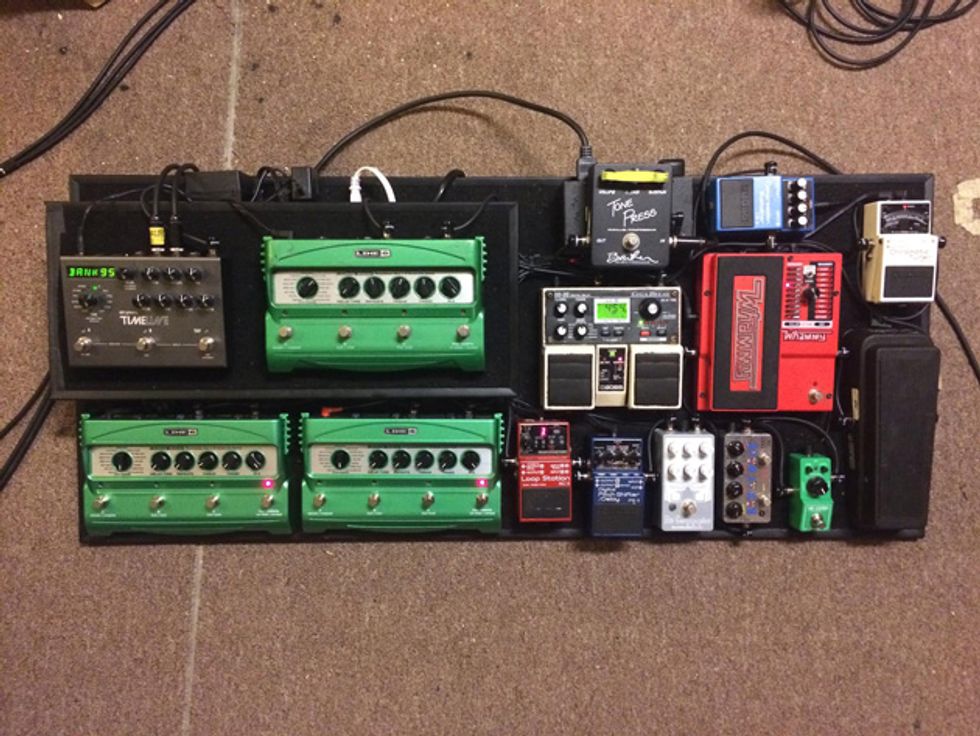


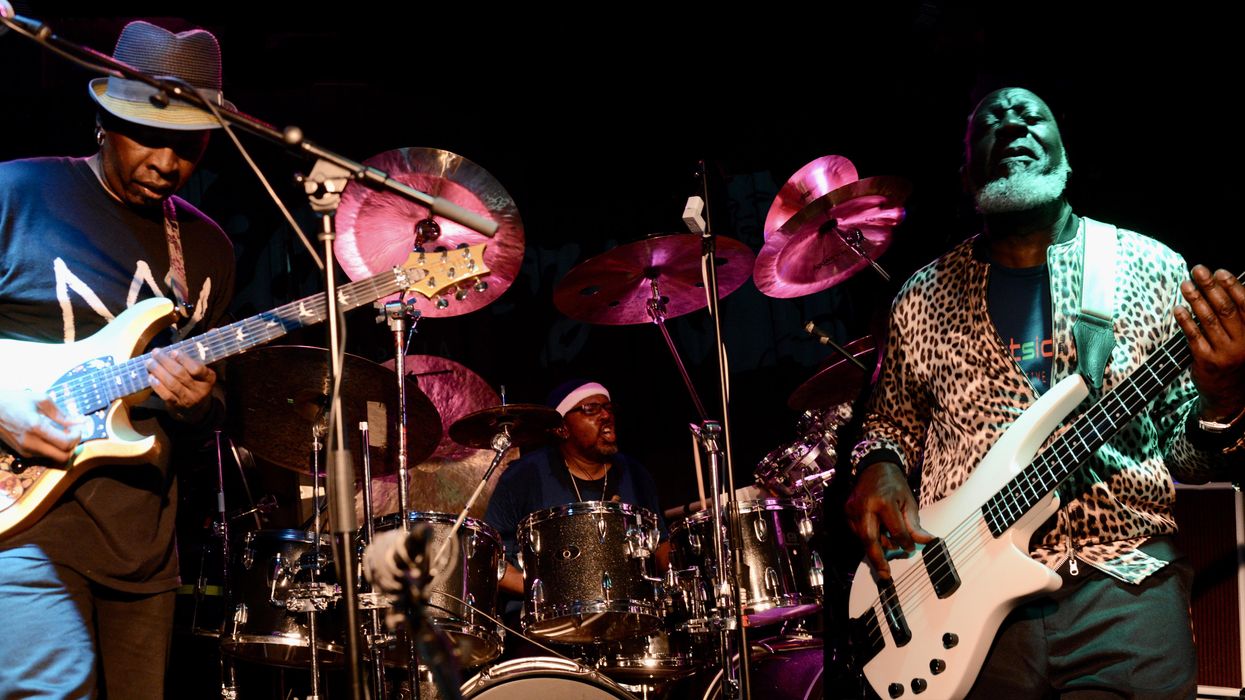



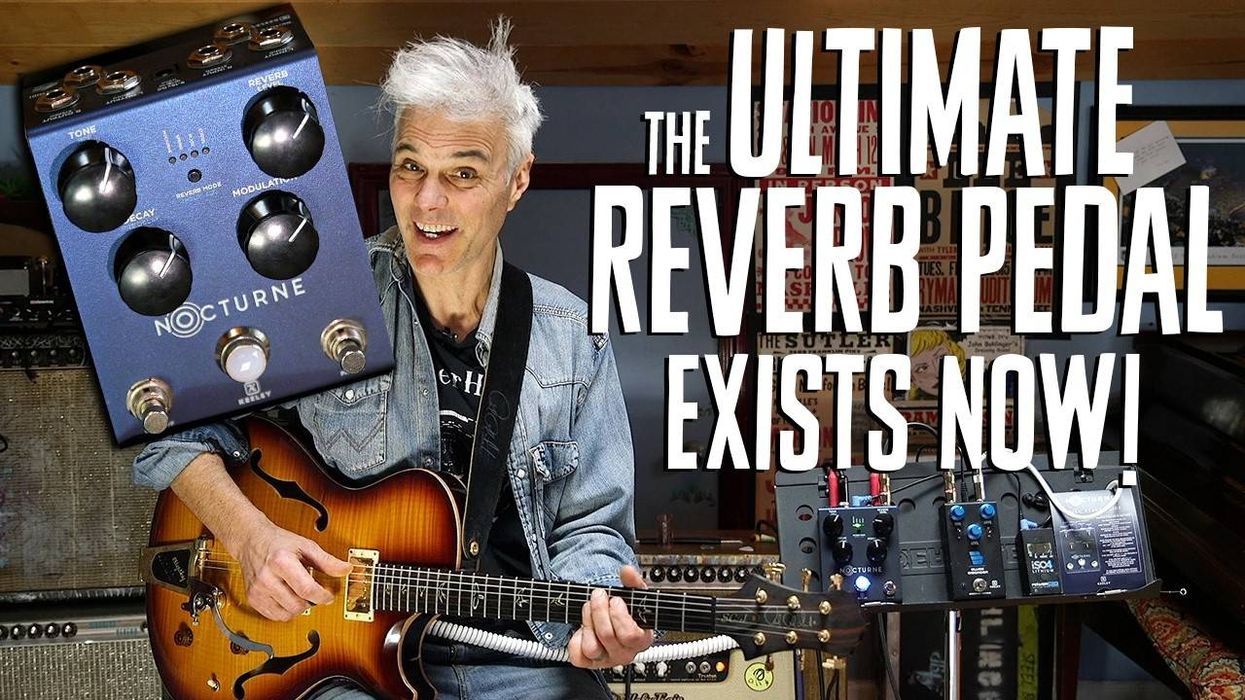
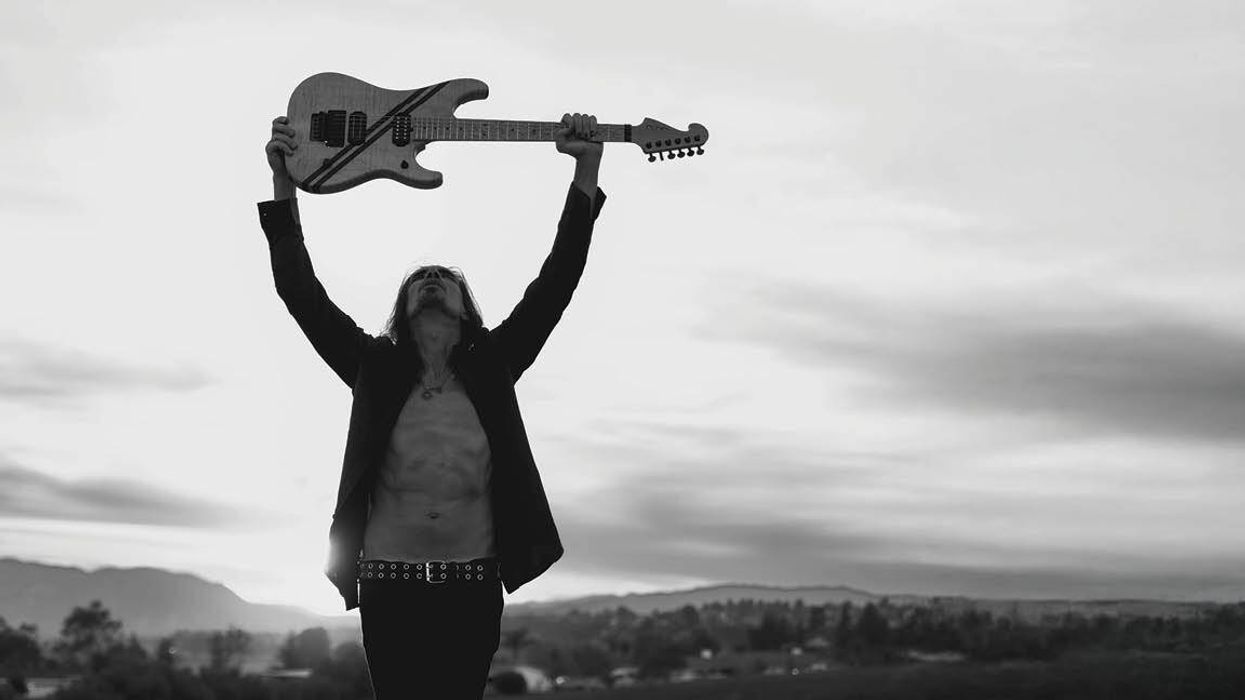
![Rig Rundown: Russian Circles’ Mike Sullivan [2025]](https://www.premierguitar.com/media-library/youtube.jpg?id=62303631&width=1245&height=700&quality=70&coordinates=0%2C0%2C0%2C0)



![Rig Rundown: AFI [2025]](https://www.premierguitar.com/media-library/youtube.jpg?id=62064741&width=1245&height=700&quality=70&coordinates=0%2C0%2C0%2C0)












 Shop Scott's Rig
Shop Scott's Rig







 Zach loves his Sovtek Mig 60 head, which he plays through a cab he built himself at a pipe-organ shop in Denver. Every glue joint is lined with thin leather for maximum air tightness, and it’s stocked with Celestion G12M Greenback speakers.
Zach loves his Sovtek Mig 60 head, which he plays through a cab he built himself at a pipe-organ shop in Denver. Every glue joint is lined with thin leather for maximum air tightness, and it’s stocked with Celestion G12M Greenback speakers.












![Devon Eisenbarger [Katy Perry] Rig Rundown](https://www.premierguitar.com/media-library/youtube.jpg?id=61774583&width=1245&height=700&quality=70&coordinates=0%2C0%2C0%2C0)
